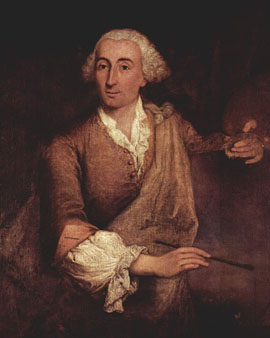In 1712 the Italian Francescco Guardi was born into a family of artists. His father was the famous baroque painter Domenico Guardi. It was through him that the young Francesco first came into contact with painting. He himself became one of the most famous Italian rococo artists.
He was trained in the workshop not only by his father, but especially by his older brother Giovanni Antonio Guardi. His cats as a painter began for the young Francesco with the completion of various altarpieces. During this time, however, he was also inspired by the work of other Italian artists, such as Michele Marieschi. Later he became a student of Bernardo Bellottos.
Both he and Marieschi are known for their detailed pictures of various cities such as Dresden, Venice or Warsaw. Guardi later followed in the footsteps of his teacher Bellotto and devoted himself to his city - Venice - in an artistic way. Unlike his predecessors, however, Guardi not only included real buildings in his works, but also imaginary buildings. The rococo artist produced his vedute on commission from the Venetian Republic or rich patrons.
Among his most famous works are the Piazza San Marco with a view to the Basilica or the gate to the Arsenal in Venice. Today his paintings are exhibited in the Louvre in Paris, the Alte Pinakothek in Munich, the Staatliche Gemäldegalerie in Berlin and of course in Venice.
×





.jpg)
.jpg)
_-_(MeisterDrucke-1462507).jpg)
_-_(MeisterDrucke-1462507).jpg)
 - (MeisterDrucke-11941).jpg)
 - (MeisterDrucke-11941).jpg)
.jpg)
.jpg)
.jpg)
.jpg)
.jpg)
.jpg)
.jpg)
.jpg)
.jpg)
.jpg)
.jpg)
.jpg)
_-_(MeisterDrucke-1659506).jpg)
_-_(MeisterDrucke-1659506).jpg)
.jpg)
.jpg)
.jpg)
.jpg)
.jpg)
.jpg)
.jpg)
.jpg)
.jpg)
.jpg)
.jpg)
.jpg)
.jpg)
.jpg)
.jpg)
.jpg)
.jpg)
.jpg)
.jpg)
.jpg)
.jpg)
.jpg)
.jpg)
.jpg)
.jpg)
.jpg)
.jpg)
.jpg)
.jpg)
.jpg)
.jpg)
.jpg)
.jpg)
.jpg)
.jpg)
.jpg)
_-_(MeisterDrucke-1659491).jpg)
_-_(MeisterDrucke-1659491).jpg)
 - (MeisterDrucke-199858).jpg)
 - (MeisterDrucke-199858).jpg)
.jpg)
.jpg)
.jpg)
.jpg)
.jpg)
.jpg)
_-_(MeisterDrucke-1659800).jpg)
_-_(MeisterDrucke-1659800).jpg)
.jpg)
.jpg)
.jpg)
.jpg)
.jpg)
.jpg)
.jpg)
.jpg)
 - (MeisterDrucke-55590).jpg)
 - (MeisterDrucke-55590).jpg)
.jpg)
.jpg)
.jpg)
.jpg)
.jpg)
.jpg)
.jpg)
.jpg)
_-_(MeisterDrucke-907172).jpg)
_-_(MeisterDrucke-907172).jpg)
.jpg)
.jpg)
.jpg)
.jpg)
.jpg)
.jpg)
_-_(MeisterDrucke-907146).jpg)
_-_(MeisterDrucke-907146).jpg)
.jpg)
.jpg)
.jpg)
.jpg)
.jpg)
.jpg)
.jpg)
.jpg)
.jpg)
.jpg)
.jpg)
.jpg)
.jpg)
.jpg)
_in_San_Nicolo_from_Lido_to_Venice_Ascens_-_(MeisterDrucke-947011).jpg)
_in_San_Nicolo_from_Lido_to_Venice_Ascens_-_(MeisterDrucke-947011).jpg)
.jpg)
.jpg)
.jpg)
.jpg)
.jpg)
.jpg)
_-_(MeisterDrucke-1514026).jpg)
_-_(MeisterDrucke-1514026).jpg)
.jpg)
.jpg)
.jpg)
.jpg)
.jpg)
.jpg)
.jpg)
.jpg)
_18th_-_(MeisterDrucke-969911).jpg)
_18th_-_(MeisterDrucke-969911).jpg)
.jpg)
.jpg)
.jpg)
.jpg)
.jpg)
.jpg)
.jpg)
.jpg)
 - (MeisterDrucke-223957).jpg)
 - (MeisterDrucke-223957).jpg)
.jpg)
.jpg)
.jpg)
.jpg)
.jpg)
.jpg)
.jpg)
.jpg)
_-_(MeisterDrucke-1081235).jpg)
_-_(MeisterDrucke-1081235).jpg)
.jpg)
.jpg)
.jpg)
.jpg)
.jpg)
.jpg)
.jpg)
.jpg)
 - (MeisterDrucke-85685).jpg)
 - (MeisterDrucke-85685).jpg)
_-_(MeisterDrucke-1659531).jpg)
_-_(MeisterDrucke-1659531).jpg)
.jpg)
.jpg)
.jpg)
.jpg)
_by_Francesco_Guardi_(1712-1793)_oil_on_canvas_-_(MeisterDrucke-1080032).jpg)
_by_Francesco_Guardi_(1712-1793)_oil_on_canvas_-_(MeisterDrucke-1080032).jpg)
_-_(MeisterDrucke-1470854).jpg)
_-_(MeisterDrucke-1470854).jpg)
.jpg)
.jpg)
.jpg)
.jpg)
.jpg)
.jpg)
 Giving a Banquet for the Ambassadors 1776-78 - (MeisterDrucke-63633).jpg)
 Giving a Banquet for the Ambassadors 1776-78 - (MeisterDrucke-63633).jpg)
_-_(MeisterDrucke-1019846).jpg)
_-_(MeisterDrucke-1019846).jpg)
_18th_century_Paris_-_(MeisterDrucke-1000431).jpg)
_18th_century_Paris_-_(MeisterDrucke-1000431).jpg)
.jpg)
.jpg)
.jpg)
.jpg)
.jpg)
.jpg)
.jpg)
.jpg)
.jpg)
.jpg)
.jpg)
.jpg)
.jpg)
.jpg)
.jpg)
.jpg)
.jpg)
.jpg)






